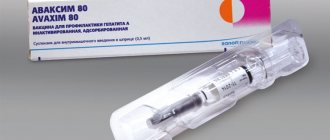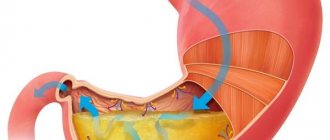Hepatitis C is a disease caused by an RNA virus. The virus can be transmitted through blood, through unsterile medical instruments, during organ and tissue transplantation, through sexual contact, from mother to child during pregnancy and childbirth. It multiplies in liver cells and causes the development of acute or chronic hepatitis. The hepatitis C virus has several genotypes; due to frequent mutations, it is resistant to human immune defense mechanisms.
Viral hepatitis C is most often asymptomatic. Only in 15% of cases of acute disease are nausea, signs of intoxication, lack of appetite observed, and jaundice is rare. A minority of patients experience hepatitis C as an acute disease and fully recover; the majority of those infected develop chronic hepatitis C. Long-term chronic disease can lead to cirrhosis or liver cancer.
At the start of the disease, antibodies to the components of the virus begin to form, first immunoglobulins M, later immunoglobulins G. Specific antibodies to the hepatitis C virus can be detected in the blood 3–8 weeks after the virus enters the body, but in some cases they may be absent for several months. In this case, infection can be confirmed by testing the blood for hepatitis C virus RNA. After infection in recovered patients, specific antibodies persist for many years with a gradually decreasing concentration and can be detected in low quantities throughout life. Antibodies to hepatitis C do not protect against re-infection when exposed to the virus again.
Those at risk for hepatitis C include doctors and nurses, people who use medical and cosmetic services, drug addicts, patients who have undergone blood transfusions or organ transplants, and children born to infected mothers who are carriers of the hepatitis C virus.
An analysis for total antibodies to the hepatitis C virus (HCV) allows you to identify specific immunoglobulins, the presence of which indicates a possible infection or a previous disease. The test is a screening test; it is mandatory to take it during hospitalization, before planned operations and during pregnancy.
What do the test results mean?
The result “Not detected” means that there are no specific antibodies to hepatitis C in the patient’s blood serum. This can be if the patient is healthy and has never been exposed to the hepatitis C virus. The absence of antibodies is possible for a short period at the beginning of the disease, when the virus has entered into the body, and the immune system has not yet produced antibodies to the hepatitis C virus (the so-called “serological window” period).
The result “Detected” means that antibodies to the virus have been detected in the blood. A positive result is always given with the results of a confirmatory test. The confirmatory test determines antibodies to structural and non-structural proteins of the hepatitis C virus.
Research result (example):
| Antibodies to hepatitis C virus, amounts | DETECTED |
| Antibodies to hepatitis C, confirmatory test | |
| Core (antibodies to structural proteins of the hepatitis C virus) | 15.26 |
| NS3 (antibodies to the non-structural protein NS3 of the hepatitis C virus) | 0.65 |
| NS4 (antibodies to the non-structural protein NS4 of the hepatitis C virus) | 0.02 |
| NS5 (antibodies to the non-structural protein NS5 of the hepatitis C virus) | 0/02 |
Antibodies can be detected in patients in several cases:
- the patient is currently ill with acute or chronic hepatitis C;
- the patient once suffered hepatitis C as an acute disease and is now healthy, the antibodies remain as an immunological memory of contact with the virus;
- the patient has a rare case of a nonspecific reaction of the blood serum with the test system used.
Detection of antibodies to the hepatitis C virus does not mean the presence of the disease and requires additional examination of the patient . If the answer is positive, it is necessary to consult the attending physician or infectious disease specialist and prescribe additional tests. A PCR test may be prescribed for HCV (detection of hepatitis C virus RNA in the patient’s blood), biochemical markers - ALT, AST, GGT, alkaline phosphatase, bilirubin, general blood test with leukocyte formula, coagulogram.
Anti-HCV are specific immunoglobulins of the IgM and IgG classes to the proteins of the hepatitis C virus, indicating possible infection or a previous infection.
Synonyms Russian
Total antibodies to hepatitis C virus, anti-HCV.
English synonyms
Antibodies to Hepatitis C Virus, IgM, IgG; HCVAb, Total.
Research method
Chemiluminescent immunoassay.
What biomaterial can be used for research?
Venous blood.
How to properly prepare for research?
- Do not smoke for 30 minutes before the test.
General information about the study
Hepatitis C virus (HCV) is an RNA virus from the Flaviviridae family that infects liver cells and causes hepatitis. It is able to multiply in blood cells (neutrophils, monocytes and macrophages, B-lymphocytes) and is associated with the development of cryoglobulinemia, Sjogren's disease and B-cell lymphoproliferative diseases. Among all the causative agents of viral hepatitis, HCV has the greatest number of variations, and due to its high mutational activity, it is able to evade the protective mechanisms of the human immune system. There are 6 genotypes and many subtypes of the virus, which have different implications for the prognosis of the disease and the effectiveness of antiviral therapy.
The main route of transmission of infection is through blood (during transfusion of blood and plasma elements, transplantation of donor organs, through non-sterile syringes, needles, instruments for tattooing, piercing). Transmission of the virus through sexual contact and from mother to child during childbirth is possible, but this occurs less frequently.
Acute viral hepatitis is usually asymptomatic and remains undetected in most cases. In only 15% of those infected, the disease is acute, with nausea, body aches, lack of appetite and weight loss, and is rarely accompanied by jaundice. 60-85% of infected people develop a chronic infection, which is 15 times higher than the frequency of chronicity with hepatitis B. Chronic viral hepatitis C is characterized by “undulation” with increased liver enzymes and mild symptoms. In 20-30% of patients, the disease leads to cirrhosis of the liver, increasing the risk of developing liver failure and hepatocellular carcinoma.
Specific immunoglobulins are produced for the core of the virus (nucleocapsid core protein), the envelope of the virus (nucleoproteins E1-E2) and fragments of the hepatitis C virus genome (NS non-structural proteins). In most patients with HCV, the first antibodies appear 1-3 months after infection, but sometimes they can be absent from the blood for more than a year. In 5% of cases, antibodies to the virus are never detected. In this case, HCV will be indicated by the detection of total antibodies to hepatitis C virus antigens.
During the acute period of the disease, antibodies of the IgM and IgG classes are formed to the nucleocapsid protein core. During the latent course of the infection and during its reactivation, IgG antibodies to the nonstructural proteins NS and the nucleocapsid core protein are present in the blood.
After an infection, specific immunoglobulins circulate in the blood for 8-10 years with a gradual decrease in concentration or remain for life in very low titers. They do not protect against viral infection and do not reduce the risk of re-infection and development of the disease.
What is the research used for?
- For the diagnosis of viral hepatitis C.
- For differential diagnosis of hepatitis.
- To detect previous viral hepatitis C.
When is the study scheduled?
- For symptoms of viral hepatitis and increased levels of liver transaminases.
- If it is known that you have had hepatitis of unspecified etiology.
- When examining people at risk for infection with viral hepatitis C.
- During screening examinations.
What do the results mean?
Reference values
Result: negative.
S/CO ratio (signal/cutoff): 0 - 1.
Reasons for an anti-HCV positive result:
- acute or chronic viral hepatitis C;
- previously suffered viral hepatitis C.
Reasons for a negative anti-HCV result:
- absence of hepatitis C virus in the body;
- early period after infection;
- absence of antibodies in viral hepatitis C (seronegative variant, about 5% of cases).
What can influence the result?
- Rheumatoid factor in the blood contributes to a false positive result.
general characteristics
Detection of general antibodies (Ig G and IgM) to hepatitis C virus antigens is used to screen patients for hepatitis C virus infection. These antibodies appear on average 4–6 weeks after infection (in some people, 3–6 months). Anti-HCV antibodies can remain in the blood of convalescents for 8-10 years with a gradual decrease in their concentration. They can also circulate in the blood of children born to hepatitis C-infected mothers, as well as after transfusion of blood containing these antibodies. Their detection indicates a possible infection with a virus or a previous infection. It is necessary to evaluate the results obtained by analyzing all factors. When conducting a differential diagnosis of alcoholic and viral hepatitis (since alcoholic hepatitis often gives false-positive results), the ALT:AST ratio should be assessed. In viral hepatitis it is more than 1, in alcoholic hepatitis the activity of AST is 2 times or more higher than ALT.
Anti-HCV, antibodies, ELISA
Anti-HCV are specific immunoglobulins of the IgM and IgG classes to the proteins of the hepatitis C virus, indicating possible infection or a previous infection.
Synonyms Russian
Total antibodies to hepatitis C virus, antiHCV.
English synonyms
Antibodies to Hepatitis C Virus, IgM, IgG; HCVAb, Total.
Research method
Chemiluminescent immunoassay.
What biomaterial can be used for research?
Venous blood.
How to properly prepare for research?
Do not smoke for 30 minutes before donating blood.
General information about the study
Hepatitis C virus (HCV) is an RNA virus from the Flaviviridae family that infects liver cells and causes hepatitis. It is able to multiply in blood cells (neutrophils, monocytes and macrophages, B-lymphocytes) and is associated with the development of cryoglobulinemia, Sjogren's disease and B-cell lymphoproliferative diseases. Among all the causative agents of viral hepatitis, HCV has the greatest number of variations, and due to its high mutational activity, it is able to evade the protective mechanisms of the human immune system. There are 6 genotypes and many subtypes of the virus, which have different implications for the prognosis of the disease and the effectiveness of antiviral therapy.
The main route of transmission of infection is through blood (during transfusion of blood and plasma elements, transplantation of donor organs, through non-sterile syringes, needles, instruments for tattooing, piercing). Transmission of the virus through sexual contact and from mother to child during childbirth is possible, but this occurs less frequently.
Acute viral hepatitis is usually asymptomatic and remains undetected in most cases. In only 15% of those infected, the disease is acute, with nausea, body aches, lack of appetite and weight loss, and is rarely accompanied by jaundice. 60-85% of those infected develop a chronic infection, which is 15 times higher than the frequency of chronicity with hepatitis B. Chronic viral hepatitis C is characterized by “undulation” with an increase in liver enzymes and mild symptoms. In 20-30% of patients, the disease leads to cirrhosis of the liver, increasing the risk of developing liver failure and hepatocellular carcinoma.
Specific immunoglobulins are produced for the core (nucleocapsid protein core), shell (nucleoproteins E1-E2) and fragments of the virus genome (NS non-structural proteins). In most patients with HCV, the first antibodies appear 1-3 months after infection, but sometimes they can be absent from the blood for more than a year. In 5% of cases, antibodies to the virus are never detected. In this case, HCV will be indicated by the detection of total antibodies to virus antigens.
During the acute period of the disease, antibodies of the IgM and IgG classes are formed to the nucleocapsid protein core. During the latent course of the infection and during its reactivation, IgG antibodies to the non-structural proteins NS and the nucleocapsid core protein are present in the blood.
After an infection, specific immunoglobulins circulate in the blood for 8-10 years with a gradual decrease in concentration or remain for life in very low titers. They do not protect against viral infection and do not reduce the risk of re-infection and development of the disease.
What is the research used for?
- For the diagnosis of viral hepatitis C.
- For differential diagnosis of hepatitis.
- To identify previously transmitted viral hepatitis C.
When is the study scheduled?
- For symptoms of viral hepatitis and increased levels of liver transaminases.
- If you know about hepatitis of unspecified etiology.
- When examining people at risk for infection with viral hepatitis C.
- During screening examinations.
What do the results mean?
Reference values
Result: negative.
S/CO ratio (signal/cutoff): 0 - 1.
Reasons for the positive result:
- acute or chronic viral hepatitis C;
- previously suffered viral hepatitis C.
Reasons for negative results:
- absence of hepatitis C virus in the body;
- early period after infection;
- absence of antibodies in viral hepatitis C (seronegative variant, about 5% of cases).
What can influence the result?
- If the material is taken and stored incorrectly, an unreliable result may be obtained.
- Rheumatoid factor in the blood contributes to a false positive result.
Important Notes
- If the result is positive, to confirm the diagnosis of hepatitis C virus, a test is performed to determine the structural and non-structural proteins of the virus (NS, Core).
- If there are existing risk factors for infection and suspicion of viral hepatitis C, it is recommended to determine the RNA of the virus in the blood by PCR, even in the absence of specific antibodies.
Also recommended
- Anti-HCV, antibodies
- Antibodies to structural and non-structural proteins of the hepatitis C virus
- HCV, RNA [real-time PCR]
- HCV, RNA quantitative [real-time PCR]
- HCV, genotyping, RNA [real-time PCR]
- anti-HAV, IgM
- HBsAg
- anti-HBc, IgM
- Gamma-glutamyl transpeptidase (gamma-GT)
- Alanine aminotransferase (ALT)
- Aspartate aminotransferase (AST)
- Total alkaline phosphatase
- Serum albumin
- Total bilirubin
- Total cholesterol
- Thrombin time
- Fibrinogen
- Complete blood count (without leukocyte formula and ESR)
- Leukocyte formula
- Erythrocyte sedimentation rate (ESR)
Who orders the study?
Infectious disease specialist, hepatologist, gastroenterologist, therapist.
Literature
- Vozianova Zh. I. Infectious and parasitic diseases: In 3 volumes - K.: Health, 2000. - T.1.: 600-690.
- Kishkun A. A. Immunological and serological studies in clinical practice. – M.: MIA LLC, 2006. – 471-476 p.
- Harrison's Principles of Internal Medicine. 16th ed. NY: McGraw-Hill; 2005: 1822-1855.
- Lerat H, Rumin S, Habersetzer F, and others. In vivo tropism of hepatitis C virus genomic sequences in hematopoietic cells: influence of viral load, viral genotype, and cell phenotype. Blood. 1998 May 15;91(10):3841-9.PMID:9573022.
- Revie D, Salahuddin SZ. Human cell types important for hepatitis C virus replication in vivo and in vitro: old assertions and current evidence. Virol J 2011 Jul 11;8:346. doi:10.1186/1743-422X-8-346. PMID:21745397.
Confirmatory test for antibodies to hepatitis C virus
Confirmatory test for antibodies to hepatitis C virus
- an indicator of infection with the hepatitis C virus, through the detection in the blood of simultaneously IgG and IgM class antibodies formed to the proteins of the hepatitis C virus to confirm screening studies.
Hepatitis C
is the most severe form of a viral disease that affects liver cells, as well as some blood cells (neutrophils, monocytes, B-lymphocytes).
The main routes of transmission of the hepatitis C virus:
- blood and/or other body fluids of an infected person;
- transplacental route;
- less often - sexual and parenteral routes (from mother to child).
One of the main risk factors for infection is injection drug use.
The high-risk group includes people who practice intravenous drug addiction, promiscuous sex, as well as medical workers, patients requiring hemodialysis or blood transfusions; prisoners. Clinical picture of hepatitis C
The main clinical manifestations of hepatitis C are very nonspecific: weakness, fatigue, nausea, lack of appetite, weight loss; With cirrhosis of the liver, jaundice may appear. As a rule, hepatitis C is asymptomatic and in most cases is diagnosed accidentally. Hepatitis C can cause either acute or chronic hepatitis infection, which is a serious, lifelong illness. A particularly severe outcome of chronic hepatitis C is liver cirrhosis and hepatocellular carcinoma.
Unlike other viral hepatitis, hepatitis C has a less clear clinical picture and in most cases becomes chronic. Most often, chronic hepatitis C leads to the development of liver cirrhosis and very rarely to the development of hepatocellular carcinoma. Autoimmune complications occur with high frequency. The duration of the incubation period is from 5 days to 3 weeks. At the end of the incubation period, the levels of liver transaminases increase, and the liver and spleen may become enlarged. The acute period occurs with weakness and loss of appetite. In 30% of cases, fever, arthralgia, and polymorphic rash occur. Dyspeptic symptoms and polyneuropathy are possible. Cholestasis occurs very rarely. Laboratory parameters reflect cytolysis.
Normally, there are no antibodies to the hepatitis C virus in the blood.
The human hepatitis C virus contains a number of proteins to which antibodies are formed. These are nucleocapsid protein C - core, shell protein E1-E2, proteins - NS1, NS2, NS3, NS4, NS5. Antibodies are formed to these proteins, which can be detected in blood serum.
The appearance of total antibodies to the hepatitis C virus in humans is characterized by variability, but on average, antibody production begins 3–6 weeks after infection. First, from 3–6 weeks of illness, IgM class antibodies begin to form. After 1.5–2 months, noticeable production of IgG antibodies begins, reaching a maximum concentration by 3–6 months of the disease. This type of antibody can be detected in blood serum for years. Therefore, detection of antibodies allows diagnosis of hepatitis C infection starting 3–6 weeks or more after infection. It should be taken into account that the detection of IgM and IgG class antibodies in this method (ELISA) is a screening test and is not sufficient to make a diagnosis of viral hepatitis C and requires a confirmatory test. Taking into account the sensitivity of modern test systems (ELISA method), it is recommended to conduct the study no earlier than 4–6 weeks after possible infection.
Indications:
- suspected viral hepatitis;
- positive data and questionable data obtained in preliminary studies for viral hepatitis C (determination of total antibodies to hepatitis C);
- confirmation of hepatitis C virus infection upon receipt of previously positive or questionable results.
Preparation
It is recommended to donate blood in the morning, between 8 am and 12 pm. Blood is drawn on an empty stomach, after 4–6 hours of fasting. It is allowed to drink water without gas and sugar. On the eve of the examination, food overload should be avoided.
Interpretation of results
Normally, there are no antibodies to hepatitis C virus proteins in the blood serum.
Positive result: infection with hepatitis C virus.
Biochemical blood test for hepatitis C
This type of diagnostics is among the most informative specialists. Based on the results of the analysis for hepatitis C, it is possible to determine the degree of organ damage and assess the general condition of the patient. The most important indicators in this laboratory test are bilirubin, AST and ALT.
Bilirubin
Normally, the amount of bilirubin in the blood should not exceed 19.8 µmol/l. An increase in pigment concentration indicates an activation of the process of erythrocyte breakdown and the presence of liver pathologies in the patient. Jaundice syndrome occurs when bilirubin levels increase above 30 µmol/l. The result of an analysis for hepatitis C with indicators from 30 to 86 µmol/l is confirmation of mild, 87-160 µmol/l - moderate, over 160 µmol/l - severe form of hyperbilirubinemia.
ALT and AST
They are enzymes produced by the liver. With HCV, their level rapidly increases and the enzymes reach the affected organ. The normal levels of AST and ALT are different for men and women. The AST level in women should be no more than 30 IU/l; in men, the test result for hepatitis C normally reaches 45 IU/l. For AST indicators, the norm is set within 30 and 47 IU/l, respectively.
Protein
The concentration of protein in the blood is affected by the process of synthesis and breakdown of two main fractions. The norm is the protein content in the blood in the range of 66-83 g/l. If, when reading tests for hepatitis C, a decrease in the indicator is detected, the presence of hepatitis or cirrhosis can be suspected.
Additional Research
Additionally, the de Ritis coefficient can be calculated, which is the ratio between ASI and ALT. In addition, changes in creatinine content, as well as an increase in triglyceride content, may indicate the development of pathologies. At the same time, do not forget that exceeding the norm of fat may indicate diabetes mellitus or obesity. The result of a test for hepatitis C based on a creatinine content of 39.9-72 µmol/l is normal. For triglycerides, the indicator is set at 3.62 µmol/l.
Preparation and delivery of blood tests for hepatitis C
The composition of the blood depends on many factors: the person’s condition; time of day; meals, etc. That is why preparation is necessary to obtain a reliable interpretation of a blood test for hepatitis C. Before donating blood, it is recommended:
- 2-3 days in advance, eliminate the consumption of alcohol, as well as fatty and fried foods;
- It is recommended to avoid stress and excessive physical activity during the day;
- You should refrain from eating any food for 8 hours before being tested for hepatitis C.
Experts also recommend stopping taking any medications. If this is not possible, your doctor should be notified.
Patients whose tests for hepatitis C have confirmed the presence of the disease should not despair. Modern medicine has means to combat the virus - drugs based on sofosbuvir, daclatasvir, velpatasvir and ledipasvir. The medicines have passed all the necessary stages of research and confirmed the effectiveness of antiviral therapy.



